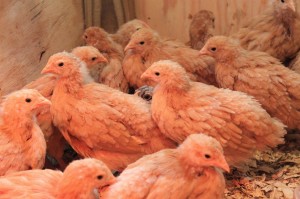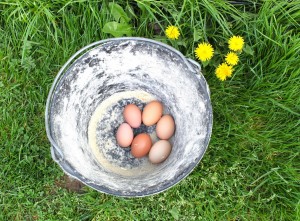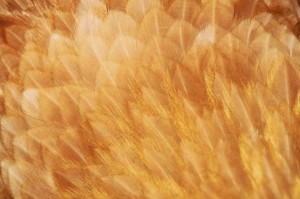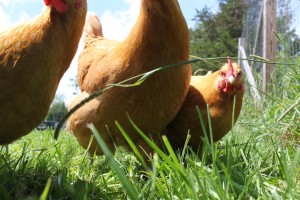THERE IS A rite of passage to fully embracing our ideal of country living up here, and it involves the chirping cardboard box. The chirping cardboard box is filled with mail order chicks. It comes from a big, folksy-friendly, commercial hatchery like Murray McMurray (its real name) in Webster, Iowa, one of the largest bird hatcheries in the U.S.
If anything has facilitated the rise of backyard chicken-keeping, it’s Murray McMurray, which has made ordering a selection of live, day-old birds so easy, anyone can do it. To accommodate the surge in backyard chicken keepers, the hatchery lets you make small orders of birds, along with coops, accessories, waterers, feeders, heaters, lamps, books, treats, supplements, and lots of things to make it feel like your new birds are sort of feathered puppies. You can order ducks, geese, turkeys, guinea fowl, chickens large or tiny or exotic or plain, chickens bred for egg laying, for good temperaments, for meat; chickens that look like cartoons, chickens in different colors, with cascading tails and mohawks and bell bottoms. They ship in a perforated box that arrives at the local post office, peeping (that’s a good sign), giving the postal clerks anxiety attacks if you don’t pick them up right away. Via postal regulations the clerks are not allowed to unseal the box, so if you’re late to get your chicks and the peeping slows down, those little deaths could be on your hands. One clerk told me that if the people didn’t come and pick it up, she might have to take those babies home herself. Someone else said that the guys driving the postal trucks don’t put the box in the back with the other packages. The chicks ride right up front, shotgun.
I married a farm boy, a bird-loving boy, whose boyhood chores included tending the chickens on his grandparents’ farm. Some guys get nostalgic about the arcades of youth; mines waxes on about birds. We courted in the 4-H building at the Ulster County Fair, murmuring down the rows of farm kids’ project birds: panting white ducks, blue-ribboned chickens, hand-drawn posters on lifespans and egg development. We got married in June, and we’d ordered chicks from the McMurray Hatchery by July: it was like purchasing a bedroom set or a new TV, a funny twist on the nesting reflex. We ordered Buff Orpingtons: a big, blonde, fluffy breed that lays big brown eggs all year long and is easy to handle. Actually, the husband chose Buff Orpingtons and I went along with it. For weeks I told people we were getting Warpingtons.
This is how I came to know and love my chickens: a series of purchases in a world I knew nothing about but just kind of blindly agreed to, because it was part of setting down roots, finally, in a way that made them stick. When you have to care for things, you can’t very well ignore them; you tend not to want to run away. First were the purchases, including that chirping box, the funny shaped waterers, the big sacks of food. Then came the actions, the decisions, the routine. At the least, you’re up early in the morning to let them out of the coop and bring up fresh food and water, down late at night to close them in, bid them goodnight as they doze up on the roost. Every single day. If I was away, the husband did it. But gravity is a strong force in domesticity, and he gravitated towards all the other critters that live here (dogs, pigeons), and I gravitated towards the chickens.
Backyard chickens are the ultimate fallacy: a back-to-the-land fantasy that has more to do with eugenics than pastoral coexistence, more with privilege than frugality. Buff Orpingtons were bred in the 1890s in Victorian England by an ex-coachman turned avian obsessive, William Cook. He started with Black Orpingtons, which looked good at livestock shows because they didn’t show the coal dust always in the air.
We got Buff Orpingtons, basically, because one of us wanted a flock of chickens that looked all the same, and one of us liked the idea of brown eggs, which have a backyard utopia look to them—the opposite of eerily identical white factory farm eggs, sitting like lost souls in their Styrofoam crates. To become self-sufficient, in terms of eggs, required an initial investment topping $2,000: chicken coop, fence, organic feed, bedding, feeders and waterers, oyster shell grit, and then a monthly nut of about $100. Offset that by two dozen eggs a week ($8), and you’re talking about a net gain of negative $2,000, give or take. This is not being a small farmer. This is indulging in a country luxury, an acquired ruralism, bringing a children’s book fantasy to life. It’s neo-farming.
~
Still, forget losing my virginity (an overrated event, probably more a male thing), graduating from college (no choice, really, on that one, given my upbringing), getting an MFA (debatable), or even moving up to Ulster County. There’s a line of demarcation to my life, and it’s very specific, very neat, and it has to do with life before the chickens came, and life after the chickens came, which is to say life during chickens. On July 23, 2010, the box of chicks arrived. We picked it up quickly, much to the postal clerk’s relief, and let the chicks out in a stall in the kennel outfitted with a heat lamp, soft bedding, a chick feeder and a chick waterer—small enough that the chicks couldn’t hop in and drown themselves, though according to my husband, chicks have smarts even before they hatch, and would know better. There were twenty-four yellow chicks and one speckled gray one, a wild card chick. All were lively and adorable and alive, which apparently beat the odds. We’d asked for only hens—McMurray’s does their best to sex them. We split the order (as if it were Chinese takeout) with our neighbors and a friend, who took the gray one too.
At two days old, they zoomed around on busy feet and chirped constantly. Within weeks their combs started to ridge over their skulls and the beaks extended, and they looked like tiny dinosaurs. “Try to get them tame,” my husband said, without specifying how, so I treated them like puppies: fed them out of my hand, talked to them, sang to them, sat down as they clambered over my lap. They became so tame that when they saw me coming, they’d all jump up and rush me for a handout. Then they’d sit in my cupped hands and fall asleep, little hearts beating against my skin.
When they were three months old, we moved them out to the fancy Amish-made chicken coop we’d bought and had delivered on a hydraulically tricked-out flatbed truck. The incongruity of this gigantic well-greased machine and the tiny creatures it was operating for had a disturbing quality to me, as if the agricultural industrial complex I wanted to forget about was always going to be within a thought’s reach. Watching the truck set that coop down its greased, steel sliders, I was hit with a fierce sense of protectiveness, and after the truck left, I had to calm down by sitting with the chicks, sweetly oblivious, miniature feathered benedictions tapping at my palms with their bumpy beaks, and I promised to keep them safe.
The flock took to their new coop, reveling in its corners and frolicking up and down the ramp, giving themselves dust baths and pulling up grass and hunting for worms, and I named them: Lucille, Marbella, Belle, Felicia, Henny, Mable, Stella, Ellie, Shirley. Each had a slightly different body shape, a different tinge to their feathers, a different comb, a different look, all variations on the theme, just like their names. Belle is square with a low roll of a comb. Lucille is darker than the others and stands slightly taller, has a high comb and an eternally worried look to her big eyes. These were names befitting the staff of the kind of beauty salon my grandmother would have gone to: she was a regular at the House of Silver Blondes on Bergenline Avenue in North Bergen, New Jersey, and something about these hens, in all their fluffy femininity, the way they stood over a pan of cracked corn like they were gossiping over canasta, reminded me of her. But naming things fosters even more attachment. There was no anonymity involved in these chickens, which meant they could, theoretically, break my heart. Backyard chickens can live between eight and fifteen years, which is plenty of time for tragedies.
~
Thoroughbreds can run so hard they snap their legs, Pugs and Persian cats can have snouts so far pushed back they can’t breathe. Here’s what Cook didn’t say about his wonder breed, Buff Orpingtons, when he so effectively touted their egg-laying abilities at an agricultural exposition in Madison Square Garden in 1903: they are so good at making giant brown eggs that sometimes those eggs actually can’t be laid. Some of my hens were laying eggs that were, literally, double the size of other eggs, with two yolks: fry them up and it looks like the twin suns of Tatooine. I wasn’t feeding the hens anything odd, wasn’t overdoing the protein, they would just squat and out would come a whopper. But I could not believe this was natural, and it turns out, it’s not. Breeding for type involves selecting for something and breeding back to it again and again, to push that trait right to the forefront, and that’s how you get big blonde birds laying big brown eggs. It is not natural selection, since this is not a trait that would enable a bird to survive. It is unnatural selection.
My husband would look at those double yolkers and shake his head. Not good, he would say, in farmboy taciturn, hard on a hen. But there was nothing to be done. You can’t shrink an egg. So we just hoped. Having animals turns hope into action, and I began to understand those old rural tropes: hoping for rain, hoping for a good crop, hoping for an easy birth. It was the part of acquired ruralism that I hadn’t anticipated: you become intimately acquainted with injury and death as inevitable parts of life.
About a year into the lives of my happy golden flock, on a steamy July day, I came back from having a swanky, long, lingering lunch (an omelet, actually), the kind of lunch one tends to have in the city, where there’s talking and thoughts and it’s a decidedly, happily, human-centric time. We’d sat at a table in a noisy restaurant and I chatted on and on about the wonders of chickens, and my lunch companion, who was a weekender, mused on whether or not she might quit her fancy job, move up full time, and try having chickens herself, were it not for the cholesterol—wait, she wanted to know, do these eggs have bad cholesterol, or is it better since they’re different eggs?
Still in lunch clothes (meaning clean), I walked up to the pen, just a customary afternoon check, and there saw one of the hens, Shirley, lying in the strong sun, looking like she had dragged herself out there. She was crouched and twisted, one wing thrust back, her legs pulled up beneath her, and her vent, where the eggs come out, was a yawning, distended maw. The other hens were clustered up in the corner of the pen, under the dark shelter of the pine tree, and were all very quiet. As I came in, they did not mob me, as usual, with their chortling greetings and cajolings for food. They stayed up in the corner, silent and wary, watching. They watched me reach down, check Shirley, find her not breathing, and pick her body up. It was still warm, still loose, and I could feel some of her muscles knit up in spasm and others flaccid, as if all the strength had gone out of them. So it had just happened.
The guilt of letting down an animal is unlike any other guilt. We consider animals, with exceptions, such as dogs that bite our children, as innocents, but what does that mean? Are they innocent of their own malice? Or innocent of our own ignorance and uncaring? Had I not gotten that second cappuccino, had I not gone on a caffeinated rant about how cool chickens are and how much I loved my new life, had I not stopped at the Mobil station to pick up cookies, had I not gone out to lunch in the first place. Because, really, farmers don’t go out to lunch. They stay on the farm, hoping through every day.
The truth is I’d been planning to research how to deal with egg-bound hens. But I didn’t. So much for strawberry chunks and organic crumbles, for a Quaker-style custom coop and the huge fenced-in pen, for all my doting and cooing. It felt as if all I did, all my fussing, was meaningless, was idiotic, the biggest hubris of all: breed a chicken that can’t lay its own egg, confine it to a pretty coop in the backyard, and be out to lunch, literally, when it needs your help. I wanted to call McMurray and tell them they’d sold a defective product, wanted to know why they would promote a chicken prone to this terrible death—especially as a chicken ideal for family backyards. Imagine your children running outside and finding their own Shirley, the lifelong scars that could result, things coming up years later, in therapy (my stupid parents thought it was a good idea but I can’t stop picturing that poor hen). I wanted to assuage my own guilt with some form of anger, but in the end, I had to let it go. Another rural trope: there are always chores to get done, good days or bad.
~
There’s no hard data on how many families have set up little chicken coops, how many backyards are dotted with hens, how many hipsters, fed up with the failures of city life, have chosen to go, as they like to say, back to the land but on a small, boutique-y scale, like a little feather and egg boutique. Back in Brooklyn, the same backyards I overlooked from a succession of railroad apartments are now graced with mini flocks, some helped along by organizations like bk farmyards (who offer chicken-keeping workshops and keep teaching flocks). Pinterest has entire pages devoted to chicken coops, including, recently, a coop done in minimalist dour black by some dour-looking young architects in Portland, populated by equally dour-looking hens, and a coop made to look like Barbie’s Dream House, a miniature castle, a coop shingled with beer cans, and cutesy-poo signs like Maison du Poulet and Wicked Chickens Lay Deviled Eggs.
Because chickens are small, it’s easy to tuck them into a little cubby of a daydream. Imagine if, instead of backyard chickens, it was backyard cows: would it be so popular? The death of Shirley brought home to me the fact that these are, in fact, chickens—not cats, not dogs, but farm animals that require husbandry and an utter lack of squeamishness. There’s not just a learning curve, there’s a desensitizing curve.
Unless you have a whole lot of cash to spare, you don’t generally bring a chicken to the vet—and among the real chicken folk around here (as in, tending big, barn-filling flocks), a good avian vet is a rare bird. Yet an inconceivably long list of maladies can afflict Gallus domesticus: bumblefoot, mites, egg binding, canker, impacted crop, prolapses, vent gleet (also known as pasty vent), respiratory infections, face-palm mishaps like a hen getting her leg pinned under a tree root and then getting her eye nearly pecked out (happened to poor Henny, renamed One-Eye since she can only see out of the good one). I started spending more time looking into the backs of my hens, not just admiring their fluffy forms. I began checking the roots of their feathers for mites, opening their beaks to check their tongues, feeling their crops to make sure they weren’t impacted. I went to visit other chicken tenders (tender as a verb, not a McDonald’s noun—we don’t discuss that around here). I learned remedies for egg binding—pouring oil down the vent, a warm bath — which worked for Mable, or perhaps I just jumped the gun and she’d have laid anyway, since right after her bath she toddled back up into the nest box and out popped a lovely, freckled egg. The success made me feel like I’d crossed into skilled territory, that I could in fact tend my flock, and we celebrated, the hens and I, with bits of strawberry and banana mixed with flax seeds, raw oats, shredded Swiss chard and lettuce, had us a real party.
These decidedly not exotic chickens have taken on another, somewhat elliptical incarnation, as just that: to city friends and family, they are the embodiment of exotic. It is a reminder of how we really live—as in, that mammoth, impersonal (and worse) agricultural industrial complex that feeds us—to watch someone just staring at a chicken, struck by the sudden realization that this here critter is not just a food product. A friend last summer wound up with Belle sitting on her lap, doing what Belle does: chortling and clucking quietly, talking, content as she got her chest scratched. Which prompted a sudden Holy shit I’m petting a chicken breast. A brunch guest wondered out loud if the eggs I’d just scrambled up, fresh from the coop, were even sanitary—as if somehow the eggs you get in a supermarket are grown in a sterile lab. Another pronounced my chickens the first sign of my own decline, forsaking my own multiple-degreed education for a putter around in chicken shit, a kind of downward mobility all the way back to primitive farmyard life. As if, back in the olden times, we all had Amish-made chicken coops and perfectly feathered flocks of agreeable golden hens that came in a cardboard box with tinfoil packets of supplements. But really, she said, searching for the right words. It’s like we’re going back to the past, you know? Like when we actually fed ourselves.
~
Were a chicken to go back to its past, it might first give a quick nod to 66 million years ago, when a 500-pound, 11-foot-long dinosaur, Anzu Wyliei, roamed the Dakotas, a recent archeological discovery dubbed the chicken from hell. This enormous, flightless bird (who looks remarkably like a young chicken wearing an ancient Roman helmet) was a ruthless plunderer of the nests of other species. And two million years before that, it would find Tyrannosaurus Rex, a distant relation who seems to have passed on some of its traits to certain roosters. In 2003 a paleontologist was out digging around in Montana when he came across a T-Rex with just enough of a still-elastic blood vessel in its leg to test its DNA. It turns out that the beast’s closest living relative, by about three amino acid sequences, is the domestic chicken.
None of this is of any consequence to my hens: what matters to them are a few hours to forage through the backyard, clean wood shavings for bedding (they like to dust bathe in them), snacks—sunflower seeds, bananas, peanuts, all used as a bribe to call them back to the coop—and safety from hawks. Also they are sophisticated social creatures, with dozens of different sounds to articulate for nearly any circumstance. And it matters to them, I think, that I’m better now at the whole chicken thing: I know how to treat injuries, I know when to bring a hen in the house (Henny lived in my office for weeks while she healed) and how to reintroduce her to the flock when she’s been gone (at night, so they all wake up together and it’s as if it never happened).
I know, much to the hen’s relief, that roosters have no place here—and since a hen doesn’t need a rooster to lay an egg, only to lay a fertile one, that’s just fine. I know that hens can count because I watched Lucille count each and every egg in the clutch I set beneath her when she went broody (meaning she wanted to have a brood). The eggs were all different, fertile, from one of those serious chickenfolk, but all that mattered to Lucille was that there were seven when she got up to go stretch her legs outside, and seven when she came back in to settle back into the nest box and keep them warm. She sat there, with one break a day—her choice—for twenty-one days through a heat wave. To keep her cool I set ice in bowls nearby, set up a fan, iced the water, but even when it hit 100 degrees, her demeanor was always the same, stoic and uncomplaining. When the chicks hatched, she taught them what to eat, where to look, how to scratch in the dirt, how to roost, which hens in the flock to avoid (bitchy Belle) and which were fine (Aunt Marbella).
Chickens are purposeful, focused creatures. All growed up, six of Lucille’s chicks went to different homes, though one, the silver, stayed with us. She’s not a Buff Orpington at all: she’s actually some kind of Silver Phoenix cross, as sleek and quick as the Buffs are square and steady. She lays little pinkish brown eggs that have a slightly nutty taste, and she and Lucille buddy up to dig worms out from under the bluestone path, talking to each other endlessly. But the funny thing is she acts like a Buff Orpington, perhaps because she was raised by one. She’ll cuddle.
Knowing what I now know, I also understand the overblown rhetoric of animal rights, which is trying to somehow—forgive me—break through our shell of ignorance, which is as much willed, like a cultivated membrane, like blinders, so we don’t really have to think about how animals are treated. But having chickens in your backyard puts a different spin on those anonymous carcasses in the meat case. These hens, who are not skittish, who are solid and fluffy and hardy, who will gambole across the lawn when called, and who tend to chortle and cuckle, are making me feel just a bit better, as if there is an alternative to the agricultural industrial complex. By sheer force of personality and fluff of feather, they seem to offset a dreadful paradigm, one brown egg at a time, and perhaps that’s the best reason to have them.







Loved this! and all the wonderful names – the handsome Buff Orpintons, Murray McMurray, monopoly seller of feathered things and brave chick Lucille. Now I know to put that “cubby of a daydream” to rest. No coops in my back yard, thanks to Jana. But a lot more appreciation for those who do.
Suzanne – thanks! You have a lovely backyard, coopless or not. I can imagine the sound of hens singing the egg laying songs on your block. would give a kind of tucson feeling to the hood.
Pingback: Mourning Becomes Leonora: For a German Shepherd | The WeeklingsThe Weeklings